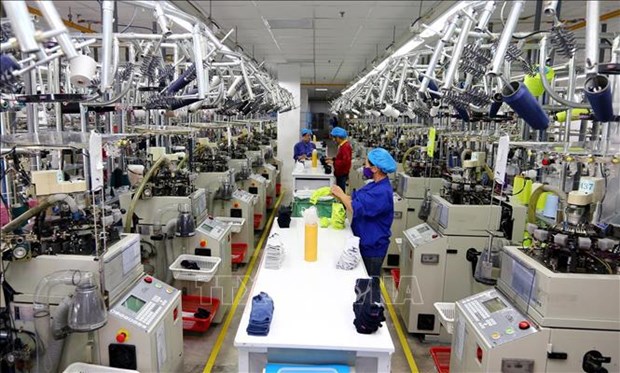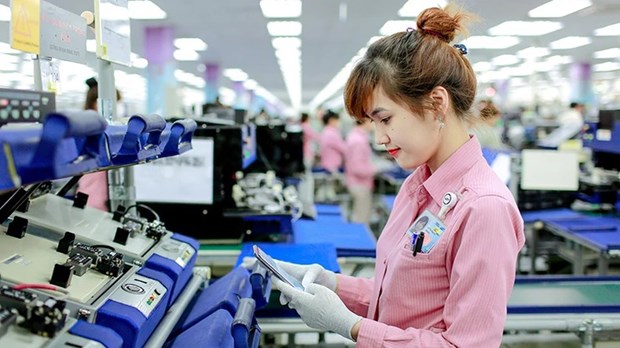Báo Bình Dương điện tử - www.baobinhduong.vn
Tổng Biên tập: LÊ MINH TÙNG
Phó Tổng Biên tập: HUỲNH MINH DÂN - NGUYỄN QUỐC LIÊM
During the 35-year journey of foreign direct investment (FDI) attraction, Vietnam has continously improved institutions and incentives to attract and better manage domestic and foreign investment resources. The expansion of economic diplomacy activities by the Party and Government in recent times has created more opportunities for Vietnam to attract high-quality capital flows into new industries.

Vietnam attracts 36.6 billion USD of FDI, an increase of more than 32% over 2022 (Photo: VNA)
During the 35-year journey of foreign direct investment (FDI) attraction, Vietnam has continously improved institutions and incentives to attract and better manage domestic and foreign investment resources. The expansion of economic diplomacy activities by the Party and Government in recent times has created more opportunities for Vietnam to attract high-quality capital flows into new industries.
In 2023, Vietnam attracted 36.6 billion USD of FDI, an increase of more than 32% over 2022. Of which, newly registered capital reached more than 20 billion USD, up 62.2%; supplemented capital reached nearly 7.9 billion USD, down 22.1%; and the total value of capital contribution by foreign investors was over 8.5 billion USD, up 65.7%.

Manufacturing electronic products at Samsung Electronics Vietnam Co., Ltd., Thai Nguyen. (Photo nhandan.vn)
Director of the Department of Industry and Construction Statistics under the General Statistics Office Phi Thi Huong Nga said that newly registered capital and capital contribution to purchase shares saw high rises, contributing to the impressive surge in the total registered FDI in 2023.
Nga acknowledged that in 2023, the economic diplomacy activities of the Party and Government were enhanced. The upgrade of Vietnam’s comprehensive strategic partnership with Japan and the US is expected to create new waves of investment.
Therefore, we can be optimistic and confident that FDI capital flows into Vietnam will continue to expand in 2024 and the following years.
Vice Chairman of the Vietnam’s Association of Foreign Invested Enterprises (VAFIE) Nguyen Van Toan said this is a turning point in the 35-year history of attracting FDI in Vietnam. Especially with its rare earth potential, Vietnam has a huge advantage in attracting high-quality capital from the US. Vietnam welcomed many delegations from large US corporations who came to explore the market and seek cooperation opportunities over the past year.
According to Toan, the promotion of investment activities by US investors in Vietnam will help increase investment activities of EU countries in Vietnam, especially countries with source technology such as Germany, the UK and Sweden.
Vietnam now has a great opportunity to attract investment like the period of the country’s joining the World Trade Organisation (WTO). But the difference is that at this time, it sees many opportunities to attract high-quality capital into new industries.
In the context of the global FDI slowdown, Vietnam is trying to implement effective solutions to attract high-quality FDI flows, including preparing conditions to to receive investment projects in the semiconductor supply chain.
According to Minister of Planning and Investment Nguyen Chi Dung, to implement the Vietnam-US Joint Statement on upgrading bilateral relations to a Comprehensive Strategic Partnership, regarding cooperation in the semiconductor industry, Vietnam has actively perfected its one-stop-shop mechanism and built a project to develop human resources in the semiconductor industry which aims to to train 50,000 engineers by 2030.
The Ministry of Planning and Investment has established the National Innovation Centre to receive investment projects in the semiconductor industry with the highest incentives. The National Assembly has also assigned the Government to conduct a comprehensive review to synchronously complete the system of policies and laws on investment promotion.
Vietnam’s main investment incentives focus on three categories, including corporate income tax, import and export taxes, and land financial incentives.
The investment attraction policy has paid off as the FDI sector has made significant contributions to the country’s socioeconomic development. In particular, several large FDI projects which were granted tax incentives such as Samsung projects in Bac Ninh and Thai Nguyen, have contributed significantly to Vietnam’s exports over recent years.
Specifically, total export turnover from Samsung projects in Vietnam reached more than 30 billion USD in 2015, accounting for 20% of Vietnam’s total export revenue. In 2022, the respective figures were 65 billion USD and 8.9%, making a considerable contribution to the country's economic recovery and development process.
According to the World Bank, Vietnam can pursue policies to attract large-scale multinational corporations with high production capacity and close links with the global value chain, thanks to its strengths in political stability, favourable geographical location and great economic openness when Vietnam has joined 15 new-generation free trade agreements.
However, the Ministry of Planning and Investment also pointed out some limitations in current investment policies. For example, investment incentives are mostly based on income but not on costs, which does not encourage substantive, long-term investment activities.
Vietnam’s investment incentive policies have not yet kept pace with advanced policies and international practices. In addition, several investment policies have been stipulated in the law, but there are no specific instructions for implementation, leading to no effect in practice. Tax incentives are also stipulated in many different tax laws, causing difficulties during implementation and increasing compliance costs./.
VNA